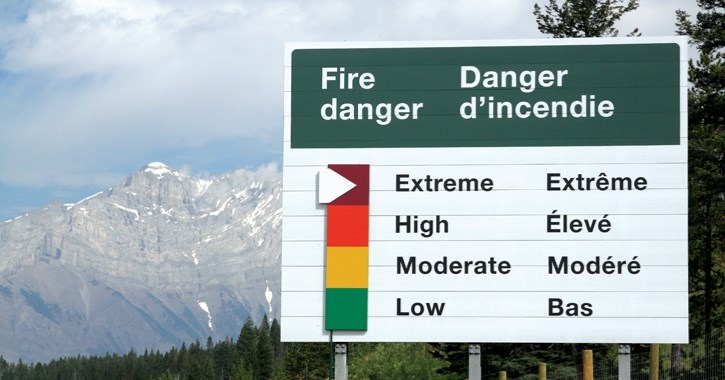BANFF – The fire danger in Banff, Yoho and Kootenay national parks has been bouncing between extreme and high over the past 10 days.
But fire experts hope the forecasted cooler temperatures and rain in the coming days will help lower the fire hazard ratings in the parks.
“This week it’s been high, but we’re expecting a cold front and a big change in the weather this afternoon and into tomorrow,” said Charlie McLellan, fire and vegetation specialist for Lake Louise, Yoho and Kootenay field unit on June 13.
“It looks like fairly wide-spread precipitation, although some of the weather forecasts last week showed some precipitation throughout our mountain parks, and we didn’t see much, but this one certainly seems like a larger change in a weather event, so hopefully we will see a decrease in fire danger.”
Banff National Park sat at extreme for much of last week, before dipping to high on Monday (June 12). While Lake Louise, Yoho and Kootenay mainly sat at high fire danger, McLellan said there were some areas rated extreme.
“When fires are in high, or extreme, they’ll ignite easily if there’s ignition, such as human ignition or lightning, they’ll spread quickly and can become challenging for ground crews,” he said.
When entering high and extreme danger ratings, McLellan said Parks Canada has guidelines within the fire management plan that help dictate the level of preparedness.
“That’s the resources we’ll have on hand and what times they’re available to suppress or action a fire,” he said.
“For example, once we get into high and extreme, we’ll always have an initial attack crew on schedule and on standby in the evenings, and then other resources, often a helicopter.”
During the latest heat wave, McLellan said there was a helicopter assigned to crews throughout the day in the event of a wildfire starting.
“Given how difficult access is in our national parks to certain areas, we’ll have a helicopter hired as well, so we can manage a fire quickly,” he said.
At certain times, McLellan said other resources can include Parks Canada highway staff and water tenders.
“We’ll have things like that in response to elevated fire danger,” he said.
If the hazard bumps from high to extreme, McLellan said there might be a change in the hours that crews are working.
“We might have crews working for longer hours and getting broader coverage,” he said.
According to Environment Canada, Banff experienced its hottest May on record, with data going back 142 years.
The average temperature in Banff in May is 8.1 Celsius, which incorporates overnight lows and daytime highs, but it was 12 C in May this year . The hottest day last month was May 15 when the mercury soared to 27.4 C.
Looking ahead to the summer, McLellan said it is too difficult to predict what may happen even though the current indices are elevated.
“June is typically our wettest month and here we are just about halfway through it and we haven’t seen a lot of precipitation yet, but next week looks to be wet, so that’s really good news,” he said.
“How dry our fuels are right now is more indicative of, say, mid-July or even into August. But June being such an important month, it’s hard to predict what the remainder of the summer will look like.”
While there has been talk of implementing a fire ban in Lake Louise, Yoho and Kootenay field unit, McLellan said the rain may mean that decision can be postponed.
He said it’s important to note that national parks have stricter rules for campfires, noting they are restricted to designated fire pits.
“Compared to our provincial agencies, it’s lower of a concern because of that general restriction,” he said.
“We’ve been talking campfire bans and we’re just hitting the thresholds now, so hopefully we’ll get enough precipitation in the storm that’s coming.”
Despite several attempts to get information and an interview from the Banff National Park field unit last week and into this week on the elevated fire hazard and resources in place to help residents feel safer, none has been forthcoming.
As for a fire ban in Banff National Park field unit, Parks Canada spokesperson Kira Tryon said the hope is rain will help bring the indices back down.
“Though, a ban could be announced as early as Thursday if we don’t get the rain,” she said in an email.




